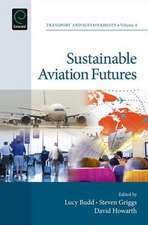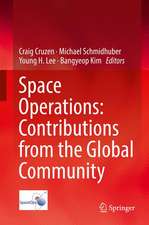Computational Space Flight Mechanics
Autor Claus Weilanden Limba Engleză Paperback – 23 noi 2014
| Toate formatele și edițiile | Preț | Express |
|---|---|---|
| Paperback (1) | 641.38 lei 6-8 săpt. | |
| Springer Berlin, Heidelberg – 23 noi 2014 | 641.38 lei 6-8 săpt. | |
| Hardback (1) | 572.96 lei 38-44 zile | |
| Springer Berlin, Heidelberg – 26 iul 2010 | 572.96 lei 38-44 zile |
Preț: 641.38 lei
Preț vechi: 754.56 lei
-15% Nou
Puncte Express: 962
Preț estimativ în valută:
122.74€ • 127.67$ • 101.33£
122.74€ • 127.67$ • 101.33£
Carte tipărită la comandă
Livrare economică 12-26 aprilie
Preluare comenzi: 021 569.72.76
Specificații
ISBN-13: 9783642432118
ISBN-10: 3642432115
Pagini: 316
Ilustrații: XIV, 300 p.
Dimensiuni: 155 x 235 x 17 mm
Greutate: 0.45 kg
Ediția:2010
Editura: Springer Berlin, Heidelberg
Colecția Springer
Locul publicării:Berlin, Heidelberg, Germany
ISBN-10: 3642432115
Pagini: 316
Ilustrații: XIV, 300 p.
Dimensiuni: 155 x 235 x 17 mm
Greutate: 0.45 kg
Ediția:2010
Editura: Springer Berlin, Heidelberg
Colecția Springer
Locul publicării:Berlin, Heidelberg, Germany
Public țintă
ResearchCuprins
Coordinate Transformations.- Transformations between Often Used Coordinate Systems.- Kepler’s Laws of Planetary Motion and Newton’s Celestial Mechanics.- The Two-Body Problem.- General Equations for Planetary Flight.- A Resumé of the Aerothermodynamics of Space Flight Vehicles.- Three and Six Degree of Freedom Trajectory Simulations.- Numerical Applications of the General Equations for Planetary Flight.- The Earth Atmosphere.- Solution of Problems.- Our Planetary System.- FORTRAN Codes.- MATLAB Codes.- Constants, Relations, Units and Conversions.
Textul de pe ultima copertă
The mechanics of space flight is an old discipline. Its topic originally was the motion of planets, moons and other celestial bodies in gravitational fields. Kepler's (1571 - 1630) observations and measurements have led to probably the first mathematical description of planet's motion. Newton (1642 - 1727) gave then, with the development of his principles of mechanics, the physical explanation of these motions.
Since then man has started in the second half of the 20th century to capture physically the Space in the sense that he did develop artificial celestial bodies, which he brought into Earth's orbits, like satellites or space stations, or which he did send to planets or moons of our planetary system, like probes, or by which people were brought to the moon and back, like capsules. Further he developed an advanced space transportation system, the U.S. Space Shuttle Orbiter, which is the only winged space vehicle ever in operation.
Today it is no problem to solve the governing equations in the most general form using discrete numerical methods. The numerical approximation schemes, the computer power and the modern storage capacity are in such an advanced state, that solutions with high degree of accuracy can be obtained in a few seconds. Therefore the general practice in this book is to provide numerical solutions for all discussed topics and problems. This could be the orbit determination by the orbital elements, Lagrange's perturbation equations for disturbed Earth's orbits, the flight of a mass point in flight path coordinates (three degree of freedom), and the flight of a controlled space vehicle in body fixed coordinates (six degree of freedom).
This book has been written not only for graduate and doctoral students but also for non-specialists who may be interested in this subject or concerned with space flight mechanics.
Since then man has started in the second half of the 20th century to capture physically the Space in the sense that he did develop artificial celestial bodies, which he brought into Earth's orbits, like satellites or space stations, or which he did send to planets or moons of our planetary system, like probes, or by which people were brought to the moon and back, like capsules. Further he developed an advanced space transportation system, the U.S. Space Shuttle Orbiter, which is the only winged space vehicle ever in operation.
Today it is no problem to solve the governing equations in the most general form using discrete numerical methods. The numerical approximation schemes, the computer power and the modern storage capacity are in such an advanced state, that solutions with high degree of accuracy can be obtained in a few seconds. Therefore the general practice in this book is to provide numerical solutions for all discussed topics and problems. This could be the orbit determination by the orbital elements, Lagrange's perturbation equations for disturbed Earth's orbits, the flight of a mass point in flight path coordinates (three degree of freedom), and the flight of a controlled space vehicle in body fixed coordinates (six degree of freedom).
This book has been written not only for graduate and doctoral students but also for non-specialists who may be interested in this subject or concerned with space flight mechanics.
Caracteristici
Presents numerical solutions of the governing equations of space flight mechanics Enables the reader to understand the compicated physics behing Incl. FORTRAN and MATLAB codes as well as solutions to problems

















